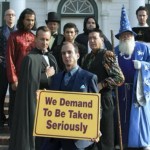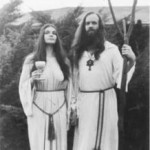Don’t let us imagine we see the sun as the old civilisations saw it. All we see is a scientific little luminary, dwindled to a ball of blazing gas. In the centuries before Ezekiel and John, the sun was still a magnificent reality, men drew forth from him strength and splendor, and gave him back homage and lustre and thanks. But in us, the connection is broken, the responsive centers are dead. Our sun is quite a different thing from the cosmic sun of the ancients, so much more trivial. We may see what we call the sun, but we have lost Helios forever. We have lost the cosmos, by coming out of responsive connection with it, and this is our chief tragedy. …
Who says the sun cannot speak to me! … What we lack is cosmic life, the sun in us and the moon in us. … We can only get the sun by a sort of worship; and the same with the moon.
— D.H. Lawrence, Apocalypse
I found myself excited about a new blogging project called, the Animist Blog Carnival which is organized by Adventures in Animism. (Unfortunately, all the links are now broken and the blog appears to have disappeared. I hope it reappears.)
[UPDATE from Mama Fauna: “Despite Heather’s regrettable absence in the blogosphere, the Animist Blog Carnival is still in operation. Home base moved over to Glen Gordon’s Post Pagan website http://postpagan.com/ & this upcoming carnival will be hosted over at Natural Pantheist Musings: http://naturalpantheist.wordpress.com/. (The carnival moves around to a new host each month.) The theme for this month is Science.”]
Each month, a different blog “hosts” the Carnival by gathering all the related posts into one place. All “animist types” are invited to participate by blogging on that month’s theme. For the purposes of this project, “animists” is an inclusive term, and can include pantheists, naturalists, eco-pagans, polytheists. If you want to participate, just post your contribution on the first of the month and send the link to that month’s host. Each month there is a different theme. May’s theme is “Place Magic”.
So I set about writing my contribution for May. I found myself struggling with it. For one thing, I have an ambiguous attitude about magic. But there are ways around that. “Magic” can mean so many things. But still I struggled, and as I did so, I had this nagging thought: “Am I really an animist?”
The Animist Blog Carnival defines “animism” very broadly and technically includes me, but I’ve never really resonated with the term. Finally, I read Traci’s post at A Sense of Place entitled, “I’m an Animist: and what that means”. It’s a great post and I urge you to read it. There are two intertwined themes that seem to run through Traci’s explanation of animism: relationship and personhood. Traci explains:
“I do have relationships, both with human and other-than-human persons, and I nurture and cherish those connections. …
“The Sun, as a Great Power, is someone I want to develop relationship with. By attending to the presence of the Sun, and actively communing, I forge connection.”
I understand attending — attending to presence, attending to place, attending to connection. But I do not understand the unconscious phenomena of the world as persons. I do not understand calling the Sun a person. Now, if this is just a rhetorical flourish intended to help us look at natural phenomena in a different way, I can appreciate that. But, reading Traci’s writing and that of other animists like Graham Harvey, it seems like the idea of personhood is more than metaphor for them.
Traci describes the Ash near her front door as “a living person, who possesses a worldview, culture, and language distinct from my own.” In fact, many animists talk about “salmon persons”, “tree persons”, and even “rock persons”. But what does “personhood” mean? Traci explains in the comments that, for her, the term “personhood” implies relationality and reciprocity. Also implied in the concept is the notion of rights. Animists want to see the rights of all “persons” respected.
I have some kind of mental block when it comes to the idea of inanimate nature as persons. The philosophical naturalist in me balks at any suggestion of personification. Animals, trees, other plants: these I see as alive. And so, in some sense, I can understand them as “persons”. I can enter into a relationship with them, not the kind of relationship I have with humans, but a kind of relationship anyway. And I can respect that they have certain rights. But rocks? What about inanimate matter?
Whenever I am having difficulty grasping animism, I turn to David Abram. In an interview by Derrick Jensen, Abram explains what it means for a rock to be alive:
“Often when discussing these notions, people will say, ‘Okay, well, sure, humans are alive. Other animals, okay, I can get that — critters have their own lives, sure. And even plants, I get that they’re alive. But stones? Rocks? Matter? No way! The matter of which this table or that chair is made? You’re going to tell me that it’s alive? I can’t go there — forget it! — that’s just inanimate matter.’
“People always want to draw the line somewhere. But you see, it’s drawing the line at all that’s the problem: the idea that at bottom matter is ultimately inert, or inanimate. The word ‘matter,’ if you listen with your animal ears, is basically the word ‘mater,’ or mother. It comes from the same indo-european root as the word “matrix,” which is Latin for ‘womb.’
“We all carry within us an ancient, ancestral awareness of matter as the womb of all things, a sense that matter is alive through and through. But to speak of matter as inanimate is to think of mother as inanimate, to imply that the female, earthly side of things is inert, is just an object. If we want to really throw a monkeywrench into the workings of the patriarchy, then we should stop speaking as though matter is in any way, at any depth, inanimate or inert.
[…]
“If we speak of matter as essentially inanimate, or inert, we establish the need for a graded hierarchy of beings: stones have no agency or experience whatsoever; bacteria have a minimal degree of life; plants have a bit more life, with a rudimentary degree of sensitivity; ‘lower’ animals are more sentient, yet still stuck in their instincts; ‘higher’ animals are more aware; while humans alone are really awake and intelligent. In this manner we continually isolate human awareness above, and apart from, the sensuous world. It takes us out of relationship with the things around us. If, however, we assume that matter is alive and self-organizing from the get-go, then hierarchies vanish, and we are left with a wildly differentiated field of animate beings, each of which has its gifts relative to the others. And we find ourselves not above, but in the very midst of this web, our own sentience part and parcel of the sensuous landscape.“
So, for the animist, there is no such thing as inanimate matter. All matter is animate, and thus alive in some sense. I think modern science can be invoked to support this notion that a matter is in motion on some level. And if we can accept the idea that all this matter is part of a complex self-regulating system (Gaia), then I can see how it all could be said to be alive. In this sense, I can understand rocks as part of that “field” of animate matter that we are immersed in. This is what I think D.H. Lawrence was describing in his essay on New Mexico:
In the oldest religion, everything was alive, not supernaturally but naturally alive. There were only deeper and deeper streams of life, vibrations of life more and more vast. So rocks were alive, but a mountain had a deeper, vaster life than a rock, and it was much harder for a man to bring his spirit, or his energy, into contact with the life of a mountain, and so he drew strength from the mountain, as from a great standing well of life, than it was to come into contact with the rock. And he had to put forth a great religious effort. For the whole life-effort of man was to get his life into contact with the elemental life of the cosmos. mountain-life, cloud-life, thunder-life, air-life, earth-life, sun-life. To come into the immediate felt contact, and so derive energy, power, and a dark sort of joy. This effort into sheer naked contact, without an intermediary or mediator, is the root meaning of religion …
How does that get us to personhood? I think that I can relate to rocks, not as persons, but as part of Person — that field of animate matter which many Pagans and religious feminists call “Goddess”. Calling rocks “persons” is still a stumbling block for me, but I think I may get to the same place by calling rocks part of a Person, Goddess.
I suppose, technically, this is a form of personification. Personification, as the term is typically used, means ascribing human qualities to non-human nature. But I don’t think that is what I am doing when I speak of Goddess. Animism recognizes that the term “person” is broader than the term “human”. Personification, then, need not mean ascribing imputing human characteristics, like consciousness, will, intention, and so on, to things that do not have these qualities. Rather, calling something a “person” means that we can enter into a “personal” relationship with that thing. It means that that “thing” is more than a thing — more than a dead thing, it is a living be-ing.
I don’t know if this is enough to qualify me as an animist. But I think that being an animist is must be less about the abstract ideas I have been discussing above, and more something that you feel in your bones. Spring is in full swing here in the Midwest. The dogwoods are in full bloom and their petals are heaped along the edges of the sidewalks. The air feels thick with new life. The birds are busy in the nest in my gazebo. The sun is shining and a cool breeze blows through the open windows of my house. On a day like this, it is easy to feel myself connected to, nay, immersed in, the material world. On a day like this, it is easy to feel that the world is overflowing with other-than-human persons. Bird persons, tree persons, and one vast Person, whose body encompasses the bright sun and the blue sky, the wind and the clouds, the soil and the grass, and the blood in my veins and the water in my cells. This is my kind of place magic. So, for today at least, I am an animist.















